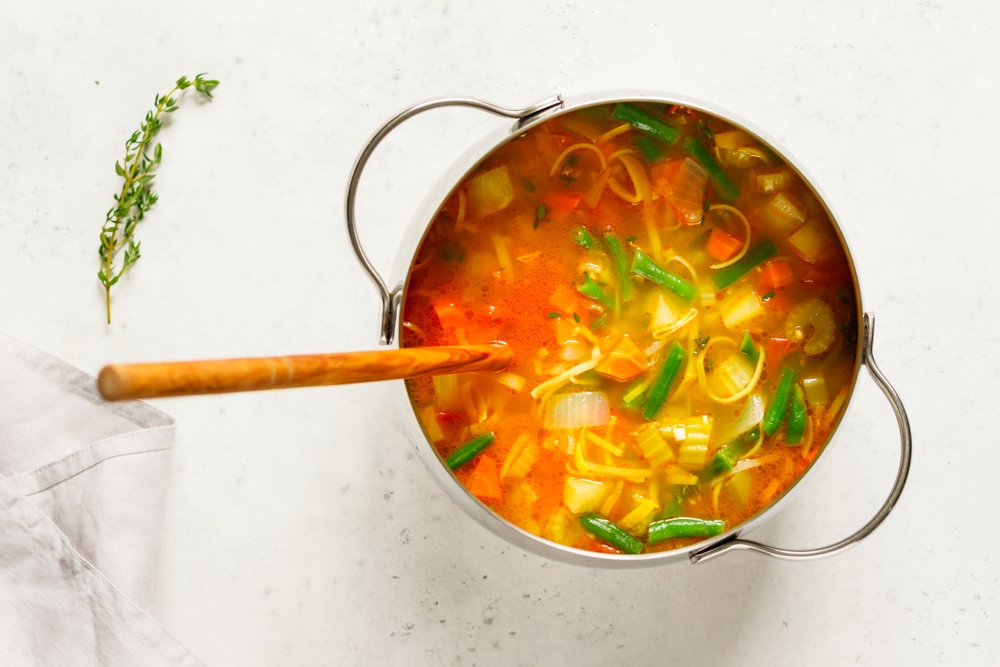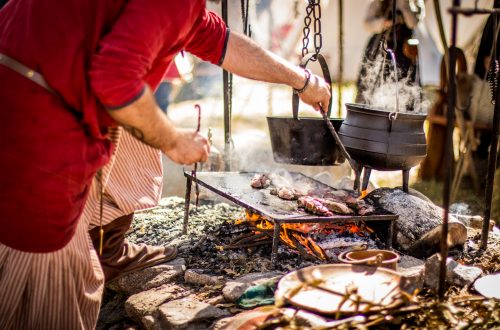
Homemade Soup
Here we are in cool weather again, hungering for a big bowl of soul-satisfying soup. That got me thinking about the way the original human habitants of our region fortified themselves in the cold months.
Native Americans had a dish made with boiled corn and, when available, venison, bear, moose, otter, racoon, or beaver, and sometimes dried fish instead of meat. For the early settlers who arrived from England, a boiling kettle of soup was a staple of their cuisine. Back then, our forebears kept the kettle on all the time and made use of vegetables, game, and cured meats to have a ready hot meal available. New Englanders ate pottage, which was boiled grain, seasonal vegetables, and seasonings finished out with meat, fowl, or fish, much like Scottish barley soup (Scotch broth). Eventually, these evolved into chowders and baked beans.
Most of us no longer have a pot sitting on the back of the cookstove, but we could learn a few things from the habits of our ancestors. For a long time, soup was served as a first course to slake the appetites and make sure that people weren’t too hungry when the costly meat arrived. My grandmother, who used everything and didn’t want to waste food, would create a soup from the unused or leftover meat and vegetables. Thanks to a good starting broth made from animal bones, those meals were always exceptional.
Soup is a soothing meal, and we’ll probably be eating a lot over the next few months. How about a discussion of what it takes to make a great soup? It’s best to begin by thinking about what type of soup you have in mind. Your version of a French potage? A German eintopf? Hungarian goulash? Vietnamese pho? Japanese miso? That will inform your preparation and seasoning. Making soup is generally simple, and you’ll likely succeed as long as you taste and adjust throughout the cooking process.
Foundational elements
Like most meals, a good soup starts with a good aromatic foundation – beginning with the broth. You can use store-bought, but don’t neglect those bones and scraps from other meals when making broth. Not only do you reduce food waste; you can create a delicious broth by combining those kitchen scraps with water and other ingredients you might have on hand. First, be sure to slowly sweat or sauté your aromatics – onions, celery, peppers. To build a deeper, nuanced flavor, sauté or roast other vegetables, such as root vegetables and squash, before adding them to the pot. As for the meat, it also helps to brown it on lower heat to cook out the fats and tenderize it. Bacon, tomato paste, herbs, Parmesan rind, and kosher salt are also all flavorful foundational elements.
Timing is important in adding ingredients. If you’re using rice or other grains that will absorb water, be sure to put them in the pot early enough to adequately cook, but also late enough so that they don’t turn to mush. Peas and potatoes also have a shorter cooking time. As for dried herbs, those like bay leaves should be added at the start of cooking. Heartier types such as thyme and rosemary can be added about halfway through. But fresh herbs such as parsley or cilantro should be added at the end of cooking. And be sure to continue to taste and adjust. When finished, consider adding a squeeze of citrus or some vinegar to brighten the taste. Too sour or harsh? Try adding a pinch of sugar. Then, taste and adjust.
When ready to serve, consider whether some toppings might add a little balance and contrast, especially if it pairs with the type of soup you have in mind. Don’t stop with just oyster crackers. Consider a spoonful of yogurt; a swirl of pesto or brown butter; some pepitas or chopped peanuts; crunched garlic chips or potato chips; shredded cheese; sesame seeds; or even a soft-cooked egg. Lastly, heat the bowls to keep the soup hot when served. Put out a basket of crusty bread and good cheese and butter, and you have the perfect autumn meal.
I’ll be taking the week off Nov. 17. Look for the next Farmboy blog just in time for Thanksgiving.
From your email, please click on the headline to view the blog and photo on the website. You can log in and comment at the end of the blog to share your thoughts and start a discussion, or suggest a topic for Farmboy in the Kitchen.
If you’d like to share the blog, click on the Facebook icon or one of the others. Thanks!




